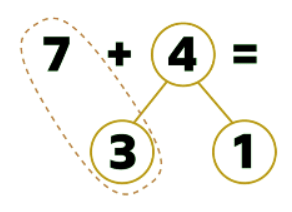Add by making 10 | Year 3 Mathematics PDF Download
Bridging Through 10
Here's how it works:
- Work out what you need to add to your first number to make ten.
- Take this amount from your second number. What remains?
- Add the remainder to 10. That's your answer!
Solved Examples
Example 1: Method 1
8 + 4 = ?
This can be solved by partitioning one of the numbers.
Here are two tens frames showing 8 orange counters. Here are 4 yellow counters which are going to be added to the 8 orange counters.
Here are 4 yellow counters which are going to be added to the 8 orange counters.
There are 2 empty spaces on the left hand ten frame.
8 + 2 = 10
We have used 2 of the yellow counters to make 10.
There are 2 yellow counters left over that are added to the second ten frame.
10 + 2 = 12
This shows 8 + 4 = 12 Method 2: The same calculation can be solved using the part-whole model.
Method 2: The same calculation can be solved using the part-whole model.
4 can be split into 2 and 2.
2 can be added to 8 to make 10.
8 + 2 = 10
Then the 10 can be added to the other 2 to make 12.
10 + 2 = 12
Which means 8 + 4 = 12
Example 2: 7 + 4 = ?
Start by working out what you need to add to 7 to make 10.
7 + ? = 10
The answer is 3.
Take this answer away from the second number in the calculation.
4 - 3 = 1
Add this answer on to 10.
10 + 1 = 11
So:
7 + 4 = 11.
This can be shown as a part-whole model like this.
|
69 videos|67 docs|11 tests
|
FAQs on Add by making 10 - Year 3 Mathematics
| 1. How can students improve their math skills by bridging through 10? |  |
| 2. Why is bridging through 10 an important concept in elementary math education? |  |
| 3. What are some strategies that students can use to bridge through 10 effectively? |  |
| 4. How can teachers incorporate bridging through 10 into their math lessons? |  |
| 5. What are some real-life applications of bridging through 10 in everyday situations? |  |





















